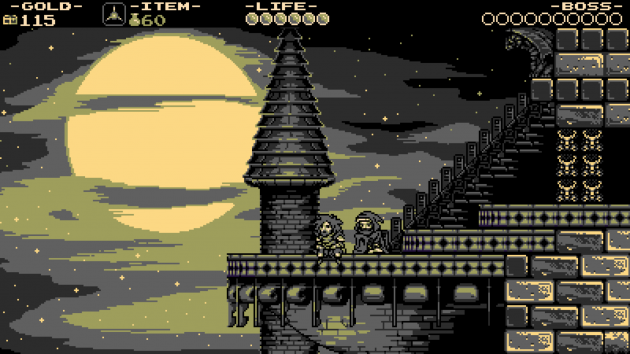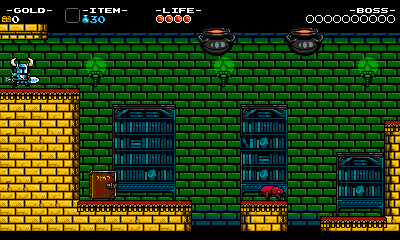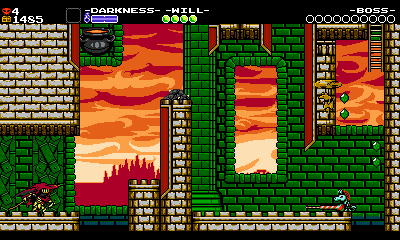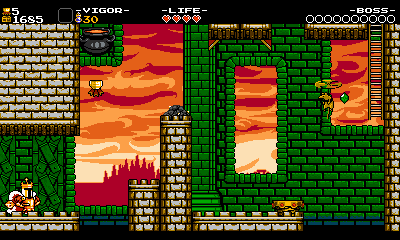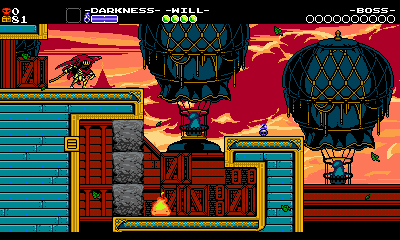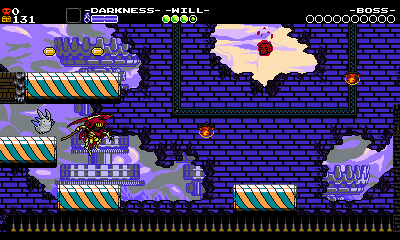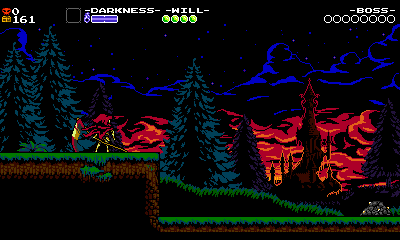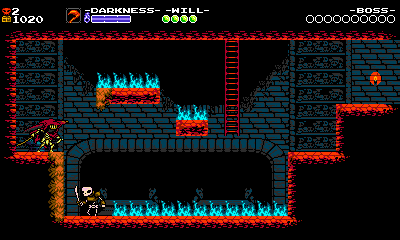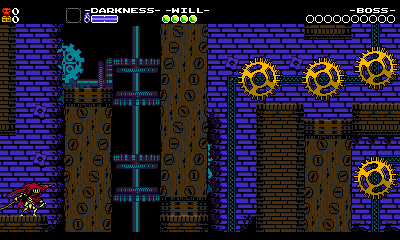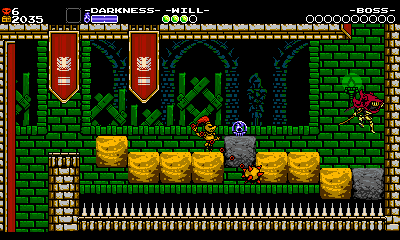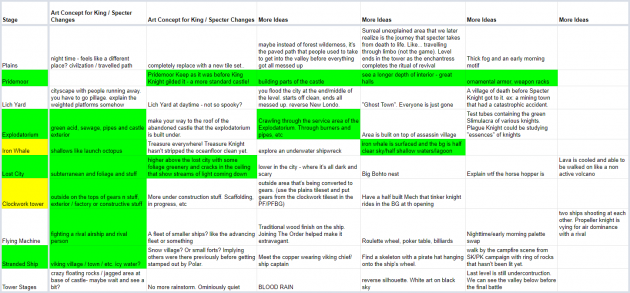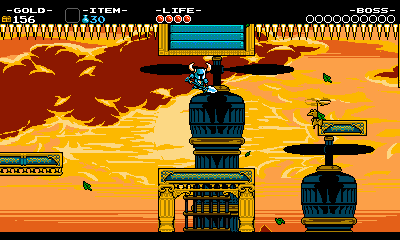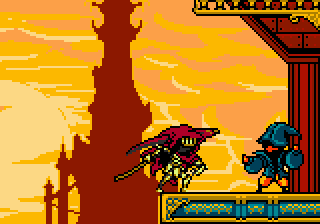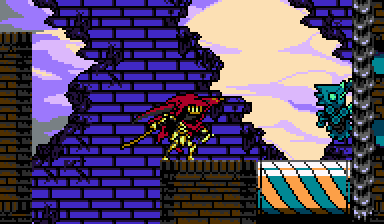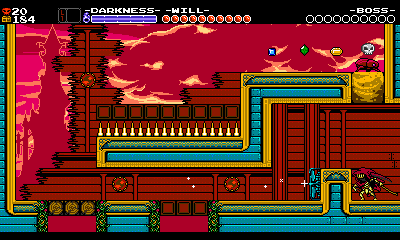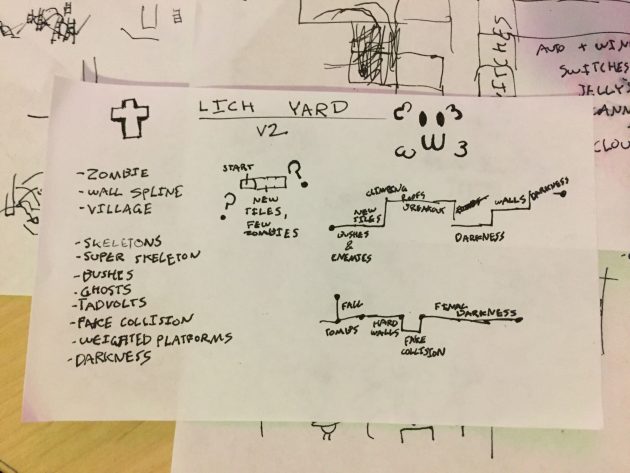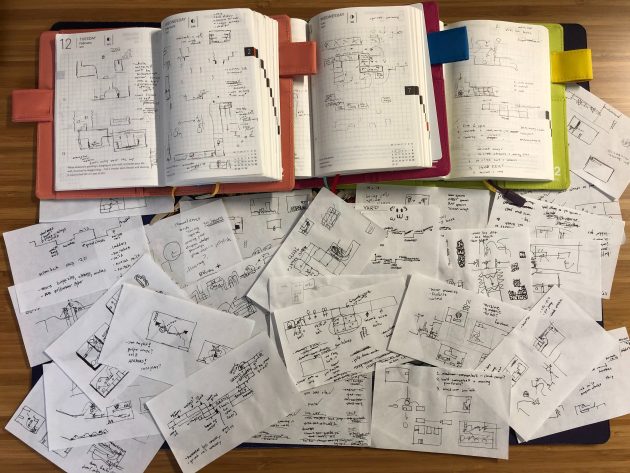Welcome, knowledge seekers! Over the course of Shovel Knight’s development, Yacht Club Games has received many requests to document and describe our level design process. However, it’s been challenging enough to develop games, much less write about them in an understandable and interesting way! But now that we’ve just finished up with Shovel Knight: Treasure Trove, we’ve had some time to collect our thoughts about our level design process and whip up a little article series! We hope to provide a little insight into the arcane mysteries of video game level design, and to codify some of the rules and practices we’ve come to value over the course of developing five Shovel Knight games.
Since King of Cards isn’t out yet, we’re gonna clutch our phase lockets and reminisce about designing levels for Shovel Knight: Specter of Torment. The levels in Specter Knight’s campaign took the greater part of a year to design, iterate, revise, test, and balance. It ended up being quite an undertaking for what could have been a much more simple boss campaign!
If you’d like a refresher on Specter Knight’s mobility and the design decisions behind it, please check out our Specter Knight Mobility article series!
We’d like to preface this by saying this surely isn’t the only way to make great platforming game levels, or that games need to follow the same development style or rules! The level design intention can be so different from game to game, and we’re constantly evolving our own design sense from project to project. With that said, let’s jump in!
Chapter 1: Game-wide Planning
Establishing Goals for Specter of Torment’s Levels
Specter of Torment is the third game in the Shovel Knight series. We began development on it right after wrapping up Plague of Shadows, a twist on the original Shovel Knight which told a story from a villainous character’s point of view. That game was fresh in our minds as we embarked on this new campaign, and many early decisions were made to differentiate our next game from that title. We were determined to create a game that was larger, scopier, and even more unique than Plague of Shadows!
Remixed Levels – 50% New & 50% Old
In Plague of Shadows, our philosophy was to craft an alternative way to control your character which would make it fun to revisit Shovel Knight’s levels without having to completely reinvent their original design. In the end, it felt fresh and exciting to have your character bomb-burst his way through those original levels, but we didn’t think it would be interesting enough to play through them a third time — no matter what mobility or system changes occurred. In order to be the best it could be, Specter of Torment would need a major level refresh.
Since you’d visit the same locations in Specter of Torment that you did in Shovel of Hope (but in the past), we started with those levels as a base. We decided to expand on their visual components and introduce alternative gameplay sections within the already established…skeleton. Specter Knight would go to places that felt familiar, but different.
This idea to embark on updated level content worked out nicely, because Specter Knight’s unique mobility necessitated drastically different level layouts! The character’s powerful abilities obviated most of the challenge in a typical Shovel Knight level. One thing that became clear quickly was that our levels would need significantly more walls and space to maneuver – walls to enable wall-running & wall-jumping, and space to allow Specter Knight to travel around the levels with his stylish and powerful Dash Slash.
In the final game, Specter’s levels ended up with way more fresh content than we’d anticipated. We began designing Specter expecting about a 50:50 new-to-old content ratio. We ultimately ended up with something closer to 95:5!
The False King
We anticipated that making new levels would be a tremendous undertaking! Early in development, we rationalized this decision by resolving to reuse the bulk of Specter Knight’s levels for King Knight’s adventure, similar to how Plague of Shadows revisits Shovel of Hope’s levels. All of the levels that Specter played through would also have to be traversable by King Knight — with a few tweaks here and there.
We really tried to stick to this plan and make it work! At one point, we even had a playable version of Specter of Torment’s Pridemoor Keep that you could fully play through as King Knight! By the time we finished Specter of Torment, we ended up adapting the levels too drastically so that they would shine with Specter’s specific mobility. After all that trouble, we ended up starting from scratch again for King Knight’s levels. Whoops! These kinds of decisions cost lots of development time, ultimately contributing to King of Cards’ 2 year development cycle– but that’s a story for another day.
New Visuals for Each Location!
Plague of Shadows was crafted as a new experience, but we found it difficult to convey that to players, in part because a screenshot of a Plague of Shadows level looks incredibly similar to a screenshot of a Shovel Knight level. It didn’t look distinctive enough for people to notice that it was largely a new game!
For Specter of Torment, we decided to make an additional tile set theme for each level, allowing us to expand on familiar areas and build entirely new ones! In this way, Specter of Torment would have its own visual identity. This often meant that we’d make interiors to complement the existing exteriors, or vice-versa. Some levels changed more than others, but they all contain plenty of visual surprises for seasoned spade-spinners and potion-pluckers!
New Objects and Enemies
Of course, it couldn’t just look different! A big part of making Specter of Torment’s levels feel new was crafting a slew of unique enemies and objects. Each addition highlighted some element of Specter Knight’s gameplay.
While a few of these concepts were resurrected from cut ideas that didn’t make it into previous Shovel Knight games, most sprung up from the needs of each individual level. The Lich Yard got some ghostly flames so the level as a whole wouldn’t feel so combat-heavy, whereas the Iron Whale got Lunkeroth so the level wouldn’t be too static.
We won’t go into detail on how we design these new elements, though it’s worth mentioning that that process is deeply intertwined with our level design process. Enemies and objects to interact with are the core building blocks of any Shovel Knight level, after all!
New Approaches to Existing Elements
In addition to implementing new ideas, we put a lot of effort into reimagining old ideas in new ways. Exhibit A: the simple and ubiquitous Dirt Block.
In Shovel of Hope, you must dig blocks out or use your Shovel Drop to destroy them. Walking over a bridge of blocks is relatively safe. But Specter Knight doesn’t have a Shovel Drop… so how would he break blocks underneath him? We decided that Specter would break blocks when he jumped off of them instead. This simple solution change had the knock-on effect of making every dirt walkway much more treacherous!
What a fantastic addition to our level design toolkit this ended up being! This interaction allowed us to breathe new life and gameplay possibilities into one of the most prevalent and useful building blocks of a Shovel Knight level!
These cannonballs from the Flying Machine are another great example of a familiar object with a fun twist. Initially, dash-slashing into a cannonball would cause Specter Knight to recoil directly into its path, meaning players would constantly get hit. Rather than try to design around an annoyance like that, we made it so Specter Knight would just slice straight through those cannonballs. This small change allowed us to come up with new gameplay possibilities…and it also gave Specter Knight a chance to do something edgy and cool!
A Re-balanced Difficulty Level
Since Specter of Torment allows you to choose the main levels in any order, some of the more difficult stages in Shovel Knight and Plague of Shadows were tailored to be a bit easier, while easier ones were amped up to be more challenging. This was a fun way to subvert returning players’ expectations. Traditionally “easy” stages like Pridemoor Keep gained a harder edge in Specter of Torment.
Plague of Shadows was criticized by some for being too difficult…and we admit we might’ve gone too far in a few places! With Specter of Torment, we wanted to make something that everyone was capable of finishing, while still offering a compelling challenge. So, we resolved to cover up a few bottomless pits and spikes here and there.
Planning Our Levels
Now that we’ve established some larger game-wide goals for our levels, it’s time to zoom in a little closer and see how we came up with a plan of attack for each individual level.
Thematic Considerations First
Every Shovel Knight level began with a thematic setting, like ‘‘village overrun by the undead’. From these settings, we brainstormed things to do. Digging up graves, battling the undead, floating across precariously murky water, or fighting with limited visibility – you know, the kinds of things one might expect to do in a creepy graveyard! The actions that the player undertakes, the challenges they encounter, the background visuals, and the level’s boss must all be thematically consistent. These elements work in unison help give a level a particular character and tone.
Since Specter of Torment was a prequel, we wondered how each of the levels could have changed in the lead-up to the events of Shovel of Hope. Would Pridemoor Castle appear worn and grey before King Knight arrived and painted it gold? Maybe the Clockwork Tower hasn’t been fully constructed yet and your path takes you outside of it?
Like most of our brainstorms, everyone throws their ideas into a spreadsheet and we discuss and greenlight the ideas we like. Here’s what Specter of Torment’s level theme spreadsheet looked like right at the start of development.
These thematic concepts inform the art, gameplay objects, and enemies that we need to design. If you’re going outside and above the Clockwork Tower, for example, then perhaps that level could use some new flying enemies! Or if we’re gonna see a more verdant, mushroomy Lost City, maybe that level could use some more goo-based objects to interact with?
With those ideas starting to percolate, it’s time we consider the specific gameplay content of each level.
Core Gameplay Ingredients
With the overarching themes determined, what will fill the moment-to-moment gameplay of each level? What are our enemies and objects and hazards going to be, and where should they go? How will they all work together?
Specter of Torment had the benefit of being the third game in the Shovel Knight series, so a great deal of the groundwork was already laid and our core levels were well established. For much of the content, we were thinking of ways to remix and iterate on what’s already there! But to make room for the new, we needed to trim out some of the old…
In that spirit, what old objects should we ditch? What concepts had been exhausted between Shovel of Hope and Plague of Shadows? We felt we’d seen enough weighted platform puzzles in the Lich Yard, or changing-direction wind-blowing rooms in the Flying Machine. We put these elements “on cooldown” for Specter and did not include them.
Some objects and enemies simply didn’t lend themselves to Specter Knight’s move set, like Flying Machine’s tricky Lightning Wizzems. These too were trimmed to make room for new content.
After brainstorming some new ideas, the team sets to work on these pieces of content. Each enemy or object needs to be flexible enough to work in a variety of contexts, but it also needs to be fun when combined with the other elements of the stage, so we usually conceptualize everything together, with a specific stage in mind.
But despite our best efforts, sometimes elements end up getting moved around later. For instance, Clockwork Tower’s flying Clockameleon enemies were initially planned to appear in the Explodatorium, but they worked much better when paired with elements that force you to jump into their paths, like rollers and drawbridges. We moved them to the Clockwork Tower, and redesigned their appearance to better fit their updated home, swapping scales for screws.
In an early version of Specter of Torment’s Flying Machine, Switch Blocks and Propellers combined for some really neat setups! But Switch Blocks worked so well with Grind Rails that we packed them up and sent them over to the Stranded Ship, scrapping an entire section of Flying Machine in the process. It’s more important that an entire level’s ingredients work in unison than it is to retain one cool idea!
General Level Rules
There’s almost enough structure in place to begin focusing on a single level at a time, but first, all levels need the same guiding constraints to ensure cohesion and uniformity. Sometimes, we’ll just dive right in and start putting rooms together, but it’s almost always better to plan them out first, to make sure we don’t run out of room for all our rooms!
The first step is to just make sure everything adheres to our basic Shovel Knight level structure and scope:
- Each level should have about 26 regular rooms and 6 secret optional rooms. This formula was counted roughly from Mega Man (which has 25 rooms) for Shovel of Hope, and used again in Specter of Torment. A consistent length means that every stage will take a similar amount of time and have a similarly digestible amount of content. Any longer or shorter and the level might drag on or feel like it was missing stuff. Players start to develop a sense of their progress, and rely on it too (“I bet I’m near the end”). Plus, it lets us reinforce or subvert that expectation later for fun!
- Each level starts with about 5 enemies and 5 objects planned. Some enemies and objects are used every level (like Dirt Blocks and Beetos). Those don’t count! All of these objects and enemies also should work together in multiple interesting ways, both in platforming and combat. No unitaskers allowed! Every element should have a considered interaction with the other elements in the level that shows why they are grouped together.
After that, we check to make sure we’re not forgetting some more general guiding principles:
- Gameplay should be taught organically and built upon in a step-by-step manner.
- No gameplay concepts should overstay their welcome, and no gameplay concepts should only show up as one-offs. Spectacles like minibosses and bosses are an exception – you can only show your “magic trick” once.
- Each level should have a good balance of platforming, exploration, and combat, and shouldn’t rely heavily on one element.
- Resources like gold, collectibles, checkpoints, and secrets should be distributed in a fun and consistent manner.
- Level mechanics should prepare you for that level’s boss fight. If Mole Knight is going to throw lava and Dirt Blocks at you, his level should have plenty of lava and Dirt Blocks!
- Specter of Torment’s levels should be recognizable as Shovel of Hope levels, but with an alternate path. They should occupy the same physical space in the world of the game.
- The shape of each stage should reinforce the level’s thematics. Many of Flying Machine’s rooms are stacked on top of one another, so as to give the feeling of ascending through the air, while most rooms in Lost City are headed downward, as you delve further and further underground towards Mole Knight’s domain. Generally, as the game progresses the levels start flatter and grow more towering in shape, as the challenges (literally) ramp up.
Once we’re reasonably sure each level has enough new ideas to support varied platforming and action-packed gameplay elements, sketching out a level plan becomes possible.
Sketching Some Level Layouts
With our theme, gameplay, and scope in mind, here’s a look at a rough plan that was developed for Specter of Torment’s Lich Yard! First we’ll go through the general purpose of each area sketched down (digitally or on paper), then a more comprehensive markup of the content for each stretch of the level.
The level’s very first sketch shows some basic layout ideas, with a list of gameplay objects that needed to be included on the left, and a very rough idea of each section of the level on the right. It starts with “bushes and enemies”, before going into sections with “darkness” and ghost “walls”, and towards the end, there’s the idea of falling into some “tombs.”
In this more detailed markup, the stage starts taking further shape. Old Shovel of Hope rooms get crossed out entirely, and new paths for Specter Knight are drawn. There aren’t any specific ideas for each room yet, but the broad gameplay idea of each section is figured out. The locations for our Wisp Chest and checkpoints are planned, as well as some spots for secret rooms. There are also thematic / art notes, with call-outs for “village”-y and “rooftop” sections.
All things considered, it’s not that far off from the final layout of the level!
There’s other ways to map things out too. Sometimes it’s helpful for us to think about the level in terms of “combat rooms” versus “platforming rooms” or “puzzle rooms” to ensure a balanced ratio of gameplay. Or sometimes we’ll anchor a stage around a few specific core ideas, and sketch those key rooms before anything else!
Planning Isn’t Everything!
Ultimately, these maps are just a starting point. As we design each level, sometimes we find fun in unexpected places which requires a different approach to the design. Sometimes, a room arrangement just doesn’t work and needs to be rethought. Sometimes, the enemies and objects themselves are the problem, and they have to be redesigned in order to make better setups. Sometimes, all this planning is just too much and it’s better to simply throw it all out and focus on some straightforward, solid platforming for a room or two! By the end of the project we’re always better at making levels, so we also loop back around to revisit earlier areas and make sure they’re up to the same level of quality we’ve reached by the end! The journey never ends…until it’s over!
Next Time: Zooming in Closer!
Level design on Specter of Torment was an all-encompassing process! We had to think about the game both in small (individual rooms, setups and mechanics) and large (overall progression, difficulty balancing, story) terms, and hold it all in our heads so as to never lose sight of the even bigger picture. Sometimes, the hardest part is just keeping it all in your brain while you work! This concept of constantly “zooming in and out” to retain cohesion is a big element of our game design process, and it’ll continue to come up throughout the course of these articles.
In the next part, we’ll explore an essential building block of every level. No, not tiles. It’s time to design some rooms!

